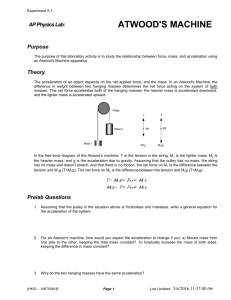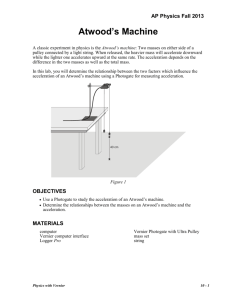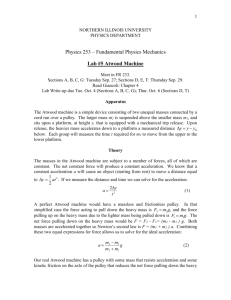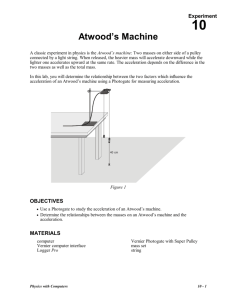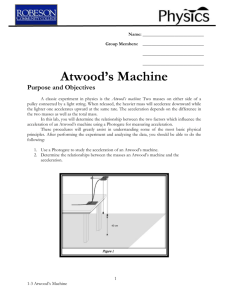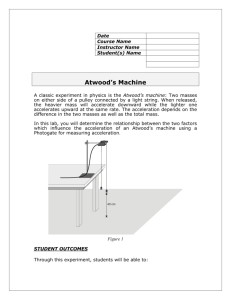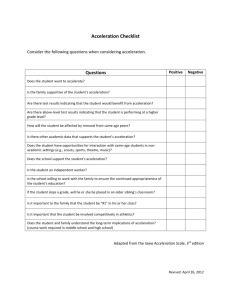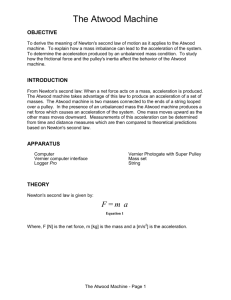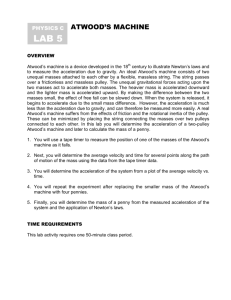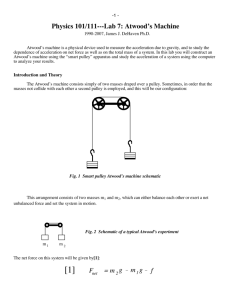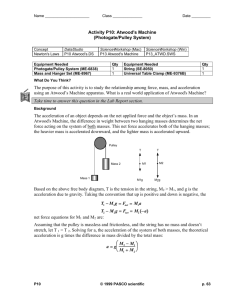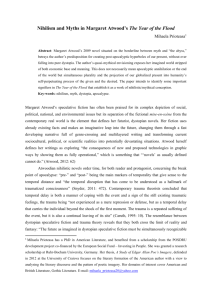Part I * Keeping Total Mass Constant
advertisement
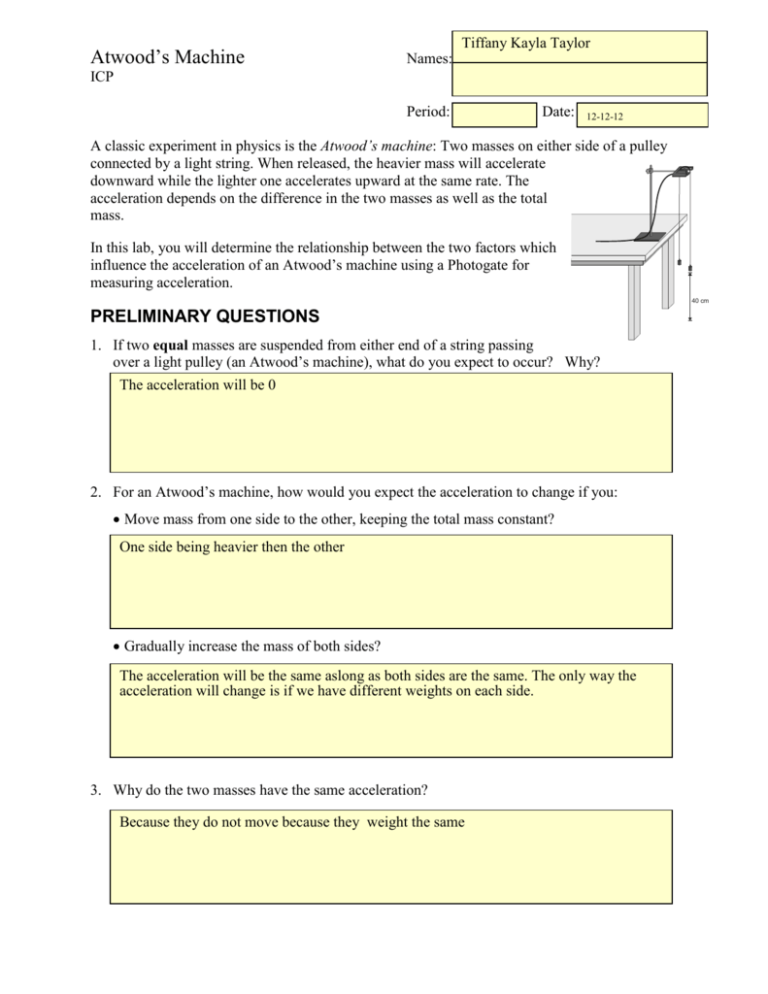
Atwood’s Machine Tiffany Kayla Taylor Names: ICP Period: Date: 12-12-12 A classic experiment in physics is the Atwood’s machine: Two masses on either side of a pulley connected by a light string. When released, the heavier mass will accelerate downward while the lighter one accelerates upward at the same rate. The acceleration depends on the difference in the two masses as well as the total mass. In this lab, you will determine the relationship between the two factors which influence the acceleration of an Atwood’s machine using a Photogate for measuring acceleration. 40 cm PRELIMINARY QUESTIONS 1. If two equal masses are suspended from either end of a string passing over a light pulley (an Atwood’s machine), what do you expect to occur? Why? The acceleration will be 0 2. For an Atwood’s machine, how would you expect the acceleration to change if you: Move mass from one side to the other, keeping the total mass constant? One side being heavier then the other Gradually increase the mass of both sides? The acceleration will be the same aslong as both sides are the same. The only way the acceleration will change is if we have different weights on each side. 3. Why do the two masses have the same acceleration? Because they do not move because they weight the same Part 1 – Keeping Total Mass Constant For this part of the experiment you will keep the total mass used constant, but move weights from one side to the other. The difference in masses change. 1. Set up the Atwood’s machine apparatus as shown in Figure 1. Be sure the heavier mass can move at least 40 cm before striking the floor. 2. Open the file “10 Atwood’s Machine” in the Physics with Vernier folder. A graph of velocity vs. time will be displayed. 3. Arrange a collection of masses totaling 200 g on m2 and a 200 g mass on m1. What is the acceleration of this combination? Record your values for mass and acceleration in the data table. (note: You don’t really need to collect any data for this trial.) 4. Move 5 g from m1 to m2. Record the new masses in the data table. 5. Position m2 as high up as it can go. Click to begin data collection. Steady the masses so they are not swinging. Wait one second and release the masses. Catch the falling mass before it strikes the floor or the other mass strikes the pulley. 6. Autoscale and then select the region of the graph where the velocity was increasing at a steady rate. Click the Linear Fit button to fit the line y = mt + b to the data. Record the slope, which is the acceleration, in the data table. 7. Continue to move masses from m2 to m1 in 5 g increments, changing the difference between the masses, but keeping the total constant. Repeat Steps 5 - 6 for each Mass 1 Mass 2 mass combination. Repeat this step until you get data for the following 200 g 200 g six combinations. 195 g 205 g 190 g 210 g 8. Complete the data table by filling in the remaining columns. 185 g 215 g 180 g 220 g 175 g 225 g DATA TABLE Part 1: Keeping Total Mass Constant m1 m2 (g) (g) 1 200 2 Trial Acceleration m (mass difference) mT (total mass) (m/s ) (g) (g) 200 0 0 400 195 205 .2256 10 400 3 190 210 .4248 20 400 4 185 215 .6874 30 400 5 180 220 .9174 40 400 6 175 225 .9000 50 400 2 Part 2 – Keeping Mass Difference Constant For this part of the experiment you will keep the difference in mass between the two sides of the Atwood’s machine constant and increase the total mass. 1. Set up the Atwood’s machine apparatus as shown in Figure 1. Be sure the heavier mass can move at least 40 cm before striking the floor. 2. Open the file “10 Atwood’s Machine” in the Physics with Vernier folder. A graph of velocity vs. time will be displayed. 3. Put 100 g on m2 and 80 g on m1. 4. Position m2 as high up as it can go. Click to begin data collection. Steady the masses so they are not swinging. Wait one second and release the masses. Catch the falling mass before it strikes the floor or the other mass strikes the pulley. 5. Autoscale and then select the region of the graph where the velocity was increasing at a steady rate. Click the Linear Fit button to fit the line y = mt + b to the data. Record the slope, which is the acceleration, in the data table. 6. Add mass in 20 g increments to both sides, keeping a constant difference of 20 grams. Record the resulting mass for each combination in the data table. Repeat Steps 5 - 6 for each mass combination. Repeat this step until you get data for the following six combinations. 7. Complete the data table by filling in the remaining columns. Mass 1 80 g 100 g 120 g 140 g 160 g 180 g Part 2: Keeping The Mass Difference Constant m1 m2 (g) (g) 1 80 2 Trial Acceleration m mT (mass difference) (total mass) 2 (m/s ) (g) (g) 100 1.029 20 180 100 120 .8529 20 220 3 120 140 .7206 20 260 4 140 160 .5995 20 300 5 160 180 .5479 20 340 6 180 200 .4923 20 380 Mass 2 100g 120 g 140 g 160 g 180 g 200g ANALYSIS Site specific example of your data to explain what happens to the acceleration if you: Move mass from one side to the other, keeping the total mass constant? The total mass is the same but the individual mass on each side changes which mean that the net force will be pulling harder on the heaver side then the lighter side. Gradually increase the mass of both sides, keeping the difference constant? The constant is always the same because the total mass is always the same we are just adding to it.
